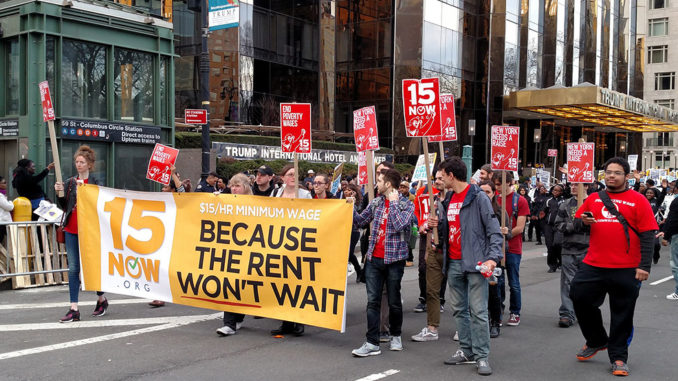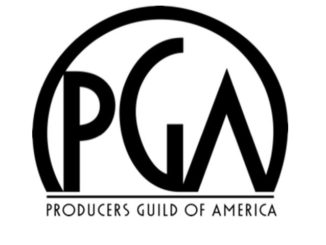
by Rob Callahan

This past April 15, thousands of workers in the fast food and other low-wage industries took to the streets nationwide to participate in the movement known as “Fight for 15” — a broad- based campaign for a $15 baseline hourly wage. The action has rightly been described as historic and, like other historic events, ought to be viewed in the context of both its time and the times that preceded it. Fight for 15 is part of a range of new organizing initiatives sometimes referred to as “alt-labor,” an array of unconventional strategic approaches to reinvigorating the labor movement. The most promising developments in alt-labor, such as this campaign, offer innovation while drawing upon established traditions of struggle for justice in the workplace.
The explosive growth of the American labor movement during the Great Depression followed a rift between the forces of craft unionism — represented by the American Federation of Labor (AFL) — and the forces of industrial unionism — represented by the Congress of Industrial Organizations (CIO). Craft unionism, as the term suggests, depends upon organization defined by specific trades; it tends to focus upon highly skilled crafts people and maintaining the scarcity of their skilled labor. Industrial unionism, on the other hand, champions organizing employees into industry-wide groups irrespective of their crafts or their relative ranks; it emerged in response to craft unions’ exclusion of minorities and unskilled laborers, and as a corrective to employers’ exploitation of jurisdictional squabbling between competing craft unions within the same industries. Although these two models of unionism often found themselves locked in bitter contest, the tensions between them helped to propel a frenzy of organizing activity.
The AFL and CIO merged in 1955, and conflict between those two unionisms no longer characterizes the US labor movement. But, just as the CIO’s philosophy of industrial organizing offered a new model of what a union could look like — thus energizing organized labor by drawing in workers previously excluded from its ranks — so certain alt-labor efforts today hold the potential for revitalizing organized labor by making space for the large pools of employees our existing models do not well serve.
If one seeks signs of life in today’s labor movement, it makes sense to look at Fight for 15, and the push for increased minimum wages more generally. With a number of behemoth employers having announced increases in their entry-level wages, several states having raised their minimum wages, and some key cities considering the establishment of a $15 minimum wage, these campaigns have achieved significant, albeit limited, wins. Indeed, these struggles have afforded some of the few recent instances of progress in a labor movement that finds itself chiefly on the defensive.
But are these fights relevant to unionized craftspeople in the entertainment industry? The vast majority of our members working union jobs already earn more than $15 per hour; our members often earn wages dramatically higher than the $15 these low-wage workers seek. So why care about Fight for 15? Does the pay of a worker flipping burgers matter to an artist cutting movies? What does the Fight for 15 mean to us?
As the usual dynamics of collective bargaining become less and less fruitful, we need to learn alternative pathways to power.
Yes, we should care. The Fight for 15 is our fight, too, regardless of the sums written on our paystubs. We may call ourselves the “Motion Picture Editors Guild” but, in truth, we are neither a guild nor are we comprised predominantly of motion picture editors. The term “guild” is an anachronism that alludes to pre-industrial confraternities of elite artisans. While our organization maintains the commitment to craft that characterized both medieval guilds and the craft unions that dominated the labor movement of the 19th century, we derive much of our bargaining power from industrial unionism — the combination of workers throughout an industry, across craft lines and across all strata of skill and pay levels. Yes, we represent elite artisans, many of them very well paid; but we represent a wide range of other hard-working professionals too, and we are stronger for that inclusivity.
Fight for 15 has been associated with the fast food and retail industries rather than with showbiz, but the entertainment industry too employs a significant number of workers paid at rates well below a living wage. Witness a job posting I happened upon recently, advertising a non-union assistant editor position. The employer wanted applicants with tenacity, excellent troubleshooting skills and expertise in Avid, tapeless workflows, syncing, grouping, script-sync, uprezzing, outputs, online prep and conforming. The pay they were offering was $100 for a 10- hour day, an effective hourly rate of $9.09 (nine cents above the California minimum wage).
For purposes of comparison, Walmart, perhaps the nation’s most notoriously low-wage employer, recently raised its national baseline wage to $9, with a bump to $10 to come in less than a year. (It should be noted that Walmart’s announcement of wage increases came only after tremendous pressure from groups of its employees backed by allies in organized labor.) For all its glamour and flashy excess, ours too is an industry in which folks can work full-time and still find themselves unable to meet basic needs.
Raising the floor on wages is obviously good for those in low- paying jobs, but it does not only benefit those employees whose pay starts in the basement. Even if you are already earning a living wage, your bargaining power is diminished by the fact that others with similar skill sets — or in the process of developing them —are working at very low rates. That’s certainly true within a given industry, but also holds true across industry lines. Conversely, increasing wages for those at the low end of the job market’s spectrum of pay can only improve the negotiating position of those already earning mid-range or higher wages.
If one seeks signs of life in today’s labor movement, it makes sense to look at Fight for 15, and the push for increased minimum wages more generally.
Moreover, Fight for 15 — by pushing for improved terms of employment outside of the conventional collective bargaining dynamic — affords opportunities to develop and test alternative means of exercising workers’ power. It is unlikely that any union will be representing large numbers of McDonald’s employees in traditional contract negotiations anytime soon. Indeed, many question whether the masses of workers at the heart of the movement will ever belong to organizations that resemble conventional labor unions.
But it’s also true that most conventional labor unions, in the midst of a decades-long decline in the clout of organized labor, have generally found it increasingly difficult to organize non-union private-sector employers and to accomplish significant gains at the negotiating table. As the usual dynamics of collective bargaining become less and less fruitful, we need to learn alternative pathways to power, pathways that may emerge from campaigns forced to forge their ways outside of our current traditions of labor relations.
Perhaps the most exciting thing about Fight for 15, though, is that it imagines the possibility of expanding the labor movement, rather than merely forestalling unions’ loss of ground. If organized labor continues to direct the entirety of its energies towards defending increasingly besieged enclaves of solid, middle-class employment in the midst of a vast wasteland of McJobs, we will ultimately find ourselves on the losing side of a war of attrition. To win, we need to enlarge the fight beyond the seven percent of the private sector that is currently unionized, beyond even the portion of the workforce that could potentially be organized into existing unions anytime soon. We need to embrace a radical inclusivity if we are to expand our movement enough to make it relevant, vital and potentially victorious.
Those who wish to roll back the gains we have won through decades of collective action depict union members as inhabiting islands of privilege. Such islands will prove indefensible unless we succeed in inviting many more allies to our shores.






